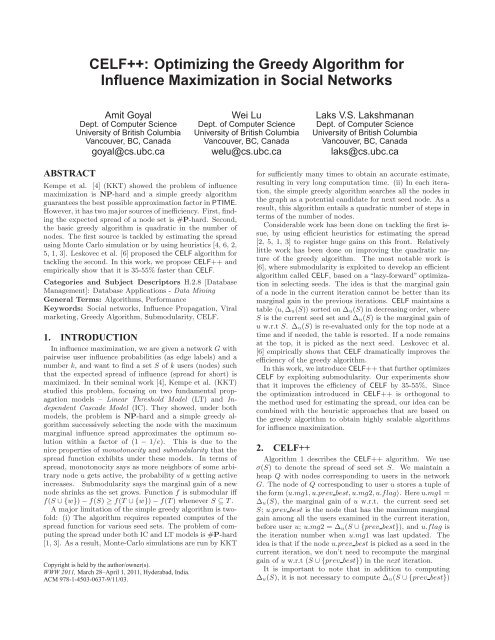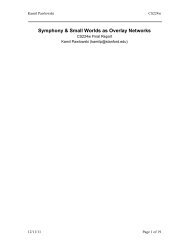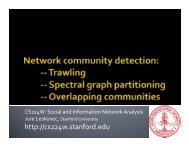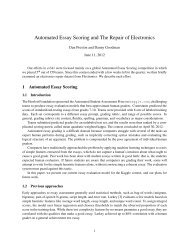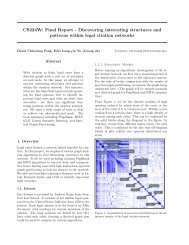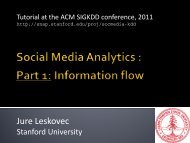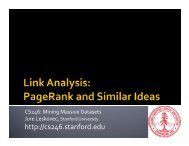CELF++: Optimizing the Greedy Algorithm for Influence ...
CELF++: Optimizing the Greedy Algorithm for Influence ...
CELF++: Optimizing the Greedy Algorithm for Influence ...
Create successful ePaper yourself
Turn your PDF publications into a flip-book with our unique Google optimized e-Paper software.
ABSTRACT<br />
<strong>CELF++</strong>: <strong>Optimizing</strong> <strong>the</strong> <strong>Greedy</strong> <strong>Algorithm</strong> <strong>for</strong><br />
<strong>Influence</strong> Maximization in Social Networks<br />
Amit Goyal<br />
Dept. of Computer Science<br />
University of British Columbia<br />
Vancouver, BC, Canada<br />
goyal@cs.ubc.ca<br />
Kempe et al. [4] (KKT) showed <strong>the</strong> problem of influence<br />
maximization is NP-hard and a simple greedy algorithm<br />
guarantees<strong>the</strong>bestpossibleapproximationfactorinPTIME.<br />
However, it has two major sources of inefficiency. First, finding<br />
<strong>the</strong> expected spread of a node set is #P-hard. Second,<br />
<strong>the</strong> basic greedy algorithm is quadratic in <strong>the</strong> number of<br />
nodes. The first source is tackled by estimating <strong>the</strong> spread<br />
using Monte Carlo simulation or by using heuristics [4, 6, 2,<br />
5, 1, 3]. Leskovec et al. [6] proposed <strong>the</strong> CELF algorithm <strong>for</strong><br />
tackling <strong>the</strong> second. In this work, we propose <strong>CELF++</strong> and<br />
empirically show that it is 35-55% faster than CELF.<br />
Categories and Subject Descriptors H.2.8 [Database<br />
Management]: Database Applications - Data Mining<br />
General Terms: <strong>Algorithm</strong>s, Per<strong>for</strong>mance<br />
Keywords: Social networks, <strong>Influence</strong> Propagation, Viral<br />
marketing, <strong>Greedy</strong> <strong>Algorithm</strong>, Submodularity, CELF.<br />
1. INTRODUCTION<br />
In influence maximization, we are given a network G with<br />
pairwise user influence probabilities (as edge labels) and a<br />
number k, and want to find a set S of k users (nodes) such<br />
that <strong>the</strong> expected spread of influence (spread <strong>for</strong> short) is<br />
maximized. In <strong>the</strong>ir seminal work [4], Kempe et al. (KKT)<br />
studied this problem, focusing on two fundamental propagation<br />
models – Linear Threshold Model (LT) and Independent<br />
Cascade Model (IC). They showed, under both<br />
models, <strong>the</strong> problem is NP-hard and a simple greedy algorithm<br />
successively selecting <strong>the</strong> node with <strong>the</strong> maximum<br />
marginal influence spread approximates <strong>the</strong> optimum solution<br />
within a factor of (1 − 1/e). This is due to <strong>the</strong><br />
nice properties of monotonocity and submodularity that <strong>the</strong><br />
spread function exhibits under <strong>the</strong>se models. In terms of<br />
spread, monotonocity says as more neighbors of some arbitrary<br />
node u gets active, <strong>the</strong> probability of u getting active<br />
increases. Submodularity says <strong>the</strong> marginal gain of a new<br />
node shrinks as <strong>the</strong> set grows. Function f is submodular iff<br />
f(S ∪{w})−f(S) ≥ f(T ∪{w})−f(T) whenever S ⊆ T.<br />
A major limitation of <strong>the</strong> simple greedy algorithm is twofold:<br />
(i) The algorithm requires repeated computes of <strong>the</strong><br />
spread function <strong>for</strong> various seed sets. The problem of computing<br />
<strong>the</strong> spread under both IC and LT models is #P-hard<br />
[1, 3]. As a result, Monte-Carlo simulations are run by KKT<br />
Copyright is held by <strong>the</strong> author/owner(s).<br />
WWW 2011, March 28–April 1, 2011, Hyderabad, India.<br />
ACM 978-1-4503-0637-9/11/03.<br />
Wei Lu<br />
Dept. of Computer Science<br />
University of British Columbia<br />
Vancouver, BC, Canada<br />
welu@cs.ubc.ca<br />
Laks V.S. Lakshmanan<br />
Dept. of Computer Science<br />
University of British Columbia<br />
Vancouver, BC, Canada<br />
laks@cs.ubc.ca<br />
<strong>for</strong> sufficiently many times to obtain an accurate estimate,<br />
resulting in very long computation time. (ii) In each iteration,<br />
<strong>the</strong> simple greedy algorithm searches all <strong>the</strong> nodes in<br />
<strong>the</strong> graph as a potential candidate <strong>for</strong> next seed node. As a<br />
result, this algorithm entails a quadratic number of steps in<br />
terms of <strong>the</strong> number of nodes.<br />
Considerable work has been done on tackling <strong>the</strong> first issue,<br />
by using efficient heuristics <strong>for</strong> estimating <strong>the</strong> spread<br />
[2, 5, 1, 3] to register huge gains on this front. Relatively<br />
little work has been done on improving <strong>the</strong> quadratic nature<br />
of <strong>the</strong> greedy algorithm. The most notable work is<br />
[6], where submodularity is exploited to develop an efficient<br />
algorithm called CELF, based on a“lazy-<strong>for</strong>ward”optimization<br />
in selecting seeds. The idea is that <strong>the</strong> marginal gain<br />
of a node in <strong>the</strong> current iteration cannot be better than its<br />
marginal gain in <strong>the</strong> previous iterations. CELF maintains a<br />
table 〈u,∆u(S)〉 sorted on ∆u(S) in decreasing order, where<br />
S is <strong>the</strong> current seed set and ∆u(S) is <strong>the</strong> marginal gain of<br />
u w.r.t S. ∆u(S) is re-evaluated only <strong>for</strong> <strong>the</strong> top node at a<br />
time and if needed, <strong>the</strong> table is resorted. If a node remains<br />
at <strong>the</strong> top, it is picked as <strong>the</strong> next seed. Leskovec et al.<br />
[6] empirically shows that CELF dramatically improves <strong>the</strong><br />
efficiency of <strong>the</strong> greedy algorithm.<br />
Inthiswork, weintroduce<strong>CELF++</strong>thatfur<strong>the</strong>roptimizes<br />
CELF by exploiting submodularity. Our experiments show<br />
that it improves <strong>the</strong> efficiency of CELF by 35-55%. Since<br />
<strong>the</strong> optimization introduced in <strong>CELF++</strong> is orthogonal to<br />
<strong>the</strong> method used <strong>for</strong> estimating <strong>the</strong> spread, our idea can be<br />
combined with <strong>the</strong> heuristic approaches that are based on<br />
<strong>the</strong> greedy algorithm to obtain highly scalable algorithms<br />
<strong>for</strong> influence maximization.<br />
2. <strong>CELF++</strong><br />
<strong>Algorithm</strong> 1 describes <strong>the</strong> <strong>CELF++</strong> algorithm. We use<br />
σ(S) to denote <strong>the</strong> spread of seed set S. We maintain a<br />
heap Q with nodes corresponding to users in <strong>the</strong> network<br />
G. The node of Q corresponding to user u stores a tuple of<br />
<strong>the</strong><strong>for</strong>m〈u.mg1,u.prev best,u.mg2,u.flag〉. Hereu.mg1 =<br />
∆u(S), <strong>the</strong> marginal gain of u w.r.t. <strong>the</strong> current seed set<br />
S; u.prev best is <strong>the</strong> node that has <strong>the</strong> maximum marginal<br />
gain among all <strong>the</strong> users examined in <strong>the</strong> current iteration,<br />
be<strong>for</strong>e user u; u.mg2 = ∆u(S ∪{prev best}), and u.flag is<br />
<strong>the</strong> iteration number when u.mg1 was last updated. The<br />
idea is that if <strong>the</strong> node u.prev best is picked as a seed in <strong>the</strong><br />
current iteration, we don’t need to recompute <strong>the</strong> marginal<br />
gain of u w.r.t (S ∪{prev best}) in <strong>the</strong> next iteration.<br />
It is important to note that in addition to computing<br />
∆u(S), it is not necessary to compute ∆u(S ∪{prev best})
from scratch. More precisely, <strong>the</strong> algorithm can be implemented<br />
in an efficient manner such that both ∆u(S) and<br />
∆u(S ∪{prev best}) are evaluated simultaneously in a single<br />
iteration of Monte Carlo simulation (which typically contains<br />
10,000 runs). In that sense, <strong>the</strong> extra overhead is relatively<br />
insignificant compared to <strong>the</strong> huge runtime gains we<br />
can achieve, as we will show from our experiments.<br />
<strong>Algorithm</strong> 1 <strong>Greedy</strong> <strong>CELF++</strong><br />
Require: G,k<br />
Ensure: seed set S<br />
1: S ← ∅; Q ← ∅; last seed = null; cur best = null.<br />
2: <strong>for</strong> each u ∈ V do<br />
3: u.mg1 = σ({u}); u.prev best = cur best; u.mg2 =<br />
σ({u,cur best}); u.flag = 0.<br />
4: Add u to Q. Update cur best based on mg1.<br />
5: while |S| < k do<br />
6: u = top (root) element in Q.<br />
7: if u.flag == |S| <strong>the</strong>n<br />
8: S ← S ∪{u};Q ← Q−{u};last seed = u.<br />
9: continue;<br />
10: else if u.prev best == last seed <strong>the</strong>n<br />
11: u.mg1 = u.mg2.<br />
12: else<br />
13: u.mg1 = ∆u(S); u.prev best = cur best; u.mg2 =<br />
∆u(S ∪{cur best}).<br />
14: u.flag = |S|; Update cur best.<br />
15: Reinsert u into Q and heapify.<br />
In addition to <strong>the</strong> data structure Q, <strong>the</strong> algorithm uses<br />
<strong>the</strong> variables S to denote <strong>the</strong> current seed set, last seed to<br />
track <strong>the</strong> id of last seed user picked by <strong>the</strong> algorithm, and<br />
cur best to track <strong>the</strong> user having <strong>the</strong> maximum marginal<br />
gainw.r.t. S overallusersexaminedin<strong>the</strong>currentiteration.<br />
The algorithm starts by building <strong>the</strong> heap Q initially (lines<br />
2-4). Then, it continues to select seeds until <strong>the</strong> budget k is<br />
exhausted. As in CELF, we look at <strong>the</strong> root element u of Q<br />
and if u.flag is equal to <strong>the</strong> size of <strong>the</strong> seed set, we pick u as<br />
<strong>the</strong> seed as this indicates that u.mg1 is actually ∆u(S) (lines<br />
6-9). The optimization of <strong>CELF++</strong> comes from lines 10-11<br />
where we update u.mg1 without recomputing <strong>the</strong> marginal<br />
gain. Clearly, this can be done since u.mg2 has already been<br />
computed efficiently w.r.t. <strong>the</strong> last seed node picked. If none<br />
of <strong>the</strong> above cases applies, we recompute <strong>the</strong> marginal gain<br />
of u (line 12-13).<br />
3. EXPERIMENTS<br />
We use two real world data sets consisting of academic<br />
collaboration networks: NetHEPT and NetPHY, both extracted<br />
from arXiv 1 . NetHEPT is taken from <strong>the</strong>“High Energy<br />
Physics – Theory”section and has 15K nodes and 32K<br />
unique edges. NetPHY is taken from <strong>the</strong> full“Physics”section<br />
and has 37K nodes and 174K unique edges. The graphs<br />
are undirected, however we make <strong>the</strong>m directed by taking<br />
<strong>for</strong> each edge <strong>the</strong> arcs in both <strong>the</strong> directions. We consider<br />
<strong>the</strong> IC model and assign <strong>the</strong> influence probability to arcs<br />
using two different settings, following previous works (e.g.,<br />
see [4, 2, 1]). In <strong>the</strong> first setting, <strong>for</strong> an arc (v,u) we set<br />
<strong>the</strong> influence probability as pv,u = 1/din(u), where din is<br />
<strong>the</strong> in-degree of <strong>the</strong> node u. In <strong>the</strong> second setting, we assign<br />
a uni<strong>for</strong>m probability of 0.1 to all arcs. In all <strong>the</strong> experiments,<br />
we run 10,000 Monte Carlo simulations to estimate<br />
<strong>the</strong> spread.<br />
1 http://www.arXiv.org<br />
Dataset<br />
Running time (min)<br />
CELF <strong>CELF++</strong> Gain<br />
Avg. # node lookups<br />
CELF <strong>CELF++</strong> Gain<br />
Hept WC 245 159 35% 18.7 13.4 28.3%<br />
Hept IC 5269 2439 53.7% 190.5 101.5 46.7%<br />
Phy WC 1241.6 667.7 46.2% 18.6 15.2 18.3%<br />
Table 1: Comparison between CELF and <strong>CELF++</strong>.<br />
Number of seeds = 100.<br />
The results are shown in Table 1. We use WC (weighted<br />
cascade) to refer to <strong>the</strong> case when <strong>the</strong> probabilities are<br />
non-uni<strong>for</strong>m and IC <strong>for</strong> <strong>the</strong> uni<strong>for</strong>m probability 0.1 setting.<br />
We only show <strong>the</strong> results corresponding to NetHEPT WC,<br />
NetHEPT IC, and NetPHY WC <strong>for</strong> brevity. The results <strong>for</strong><br />
NetPHY IC are similar. In <strong>the</strong>se settings, we found that<br />
computing u.mg2 <strong>for</strong> all nodes in <strong>the</strong> first iteration results in<br />
large overhead. So, we apply <strong>CELF++</strong> starting from <strong>the</strong> second<br />
iteration. Notice that <strong>the</strong> optimization behind <strong>CELF++</strong><br />
can be applied starting from any iteration. As can be seen,<br />
<strong>CELF++</strong> is significantly faster than CELF. This is due to<br />
<strong>the</strong> fact that <strong>the</strong> average number of“spread computations”<br />
per iteration is significantly lower. Since we apply <strong>the</strong> optimization<br />
starting from <strong>the</strong> second iteration, we report <strong>the</strong><br />
average number of nodes examined starting from <strong>the</strong> third<br />
iteration.<br />
Memory Consumption: Although <strong>CELF++</strong> maintains<br />
a larger data structure to store <strong>the</strong> look-ahead marginal<br />
gains (u.mg2) of each node, <strong>the</strong> increase of <strong>the</strong> memory consumption<br />
is insignificant. For instance, CELF consumes 21.9<br />
MB <strong>for</strong> NetHEPT and 39.7 MB <strong>for</strong> NetPHY, while <strong>CELF++</strong><br />
uses 22.4 MB and 41.2 MB respectively.<br />
4. CONCLUSIONS<br />
In this work, we presented <strong>CELF++</strong>, a highly optimized<br />
approachbasedon<strong>the</strong>CELFalgorithm[6]inordertofur<strong>the</strong>r<br />
improve <strong>the</strong> naive greedy algorithm <strong>for</strong> influence maximization<br />
in social networks [4]. <strong>CELF++</strong> exploits <strong>the</strong> property<br />
of submodularity of <strong>the</strong> spread function <strong>for</strong> influence propagation<br />
models (e.g., Linear Threshold Model and Independent<br />
Cascade Model) to avoid unnecessary re-computations<br />
of marginal gains incurred by CELF. Our empirical studies<br />
on real world social network datasets show that <strong>CELF++</strong><br />
works effectively and efficiently, resulting in significant improvements<br />
in terms of both running time and <strong>the</strong> average<br />
number of node look-ups.<br />
5. REFERENCES<br />
[1] W. Chen, C. Wang, and Y. Wang. Scalable influence<br />
maximization <strong>for</strong> prevalent viral marketing in large-scale<br />
social networks. In KDD 2010.<br />
[2] W. Chen, Y. Wang, and S. Yang. Efficient influence<br />
maximization in social networks. In KDD 2009.<br />
[3] W. Chen, Y. Yuan, and L. Zhang. Scalable influence<br />
maximization in social networks under <strong>the</strong> linear threshold<br />
model. In ICDM 2010.<br />
[4] D. Kempe, J. Kleinberg, and É. Tardos. Maximizing <strong>the</strong><br />
spread of influence through a social network. In KDD 2003.<br />
[5] M. Kimura and K. Saito. Tractable models <strong>for</strong> in<strong>for</strong>mation<br />
diffusion in social networks. In PKDD 2006.<br />
[6] J. Leskovec et al. Cost-effective outbreak detection in<br />
networks. In KDD 2007.


